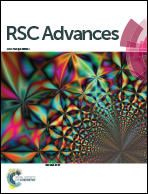Incorporating doped carbon nanodots and metal ions as an excellent artificial peroxidase for H2O2 detection†
Abstract
Novel nitrogen-doped carbon nanodots (NCdots) were successfully synthesized by a hydrothermal method using 1-(3-dimethylaminopropyl)-3-ethylcarbodiimide hydrochloride (EDC) as a carbon–nitrogen source. The NCdots were characterized by methods including TEM, EDX, SAED, XPS, and UV-vis. The NCdots were found to possess intrinsic chromogenic activity, which could be used as an excellent artificial peroxidase to oxidize H2O2 catalytically by metal ions to produce a chromogenic reaction. The reason for the chromogenic mechanism might be attributed to the structural alteration of NCdots by free radical scavenging similar to Fenton's reagent in the presence of H2O2. This offers a simple and selective colorimetric method for the determination of some metal ions in environmental systems.



 Please wait while we load your content...
Please wait while we load your content...